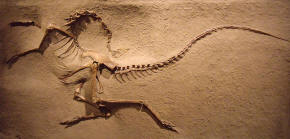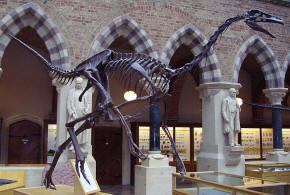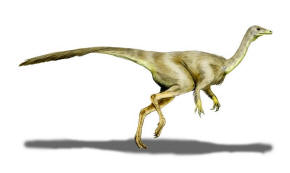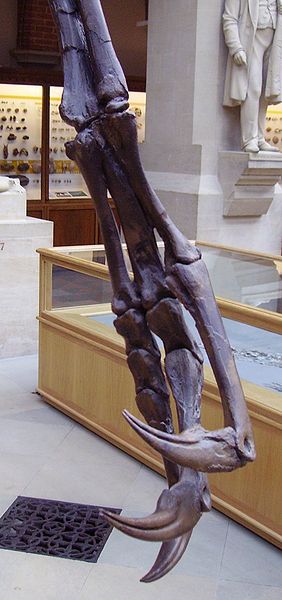|
As with other ornithomimids, it had a small slender head on a long neck
(which made up about 40% of the length of the body in front of the hips).
Its eyes were large and its jaws were toothless. Its vertebral column had
ten neck vertebrae, sixteen back vertebrae, six hip vertebrae, and an
unknown number of tail vertebrae. The tail was
stiff and was probably used for balance.
Struthiomimus
had long slender arms and hands, with immobile forearm bones but limited opposability between the first finger and the other two.
It had the longest hands of any ornithomimid, with particularly long claws.
The three fingers were roughly the same length, and the claws were only
slightly curved;
Henry Fairfield Osborn,
describing a skeleton in 1917, compared the arm to that of a
sloth.
Its shin was longer than
its thigh, a
cursorial feature.
Among ornithomimids, though, its legs were only moderately elongate.
Its feet were elongate, and the metatarsals were
tightly appressed, with three toes tipped by claws with very slight
curvature.
Struthiomimus,
being a member of
Coelurosauria, probably had feathers, especially if
the
Ornithomimosauria and
the
alvarezsauridae (of
which at least one member,
Shuvuuia is known to have been feathered)
are closely related.
Discovery
and species
In 1901,
Lawrence Lambe found some incomplete remains
and named them
 |
| Cast of a nearly complete Struthiomimus altus specimen,
found in 1914 (Picture
Source) |
Ornithomimus altus,
placing them in the same genus as material earlier described by
Othniel Charles Marsh
in 1890. The specific name altus
is from
Latin, meaning "lofty"
or "noble". However, in 1914, a nearly complete skeleton was discovered by
Barnum Brown at the
Red Deer River site in
Alberta, and officially described as the separate genus
Struthiomimus by
Henry Fairfield Osborn
in 1917.
Struthiomimus altus
comes from the Late
Campanian (Judithian
age)
Dinosaur Park Formation.
A species of Struthiomimus
is also known from the Late Campanian/Early
Maastrichtian (Edmontonian age)
Horseshoe Canyon Formation.
Because dinosaur fauna show rapid turnover, it is possible that these
younger Struthiomimus
specimens will prove to be a species distinct from
S. altus, though no new
name has been given to them. Struthiomimus
specimens from the
Hell Creek Formation
are larger (similar to
Gallimimus in size) and tend to have
straighter and more elongate hand claws, similar to those seen in
Ornithomimus. They most
likely represent a separate species of
Struthiomimus, named
Struthiomimus sedens
(again, originally named as a species of
Ornithomimus by Marsh, in 1892).
Classification
|
The
cladogram
presented here follows the one recovered by Turner, Clarke, Ericson
and Norell, 2007. Clade names follow definitions provided by Sereno,
2005.
|
Struthiomimus
is a member of the family Ornithomimidae, a group which also includes
Anserimimus,
Archaeornithomimus,
Dromiceiomimus,
Gallimimus,
Ornithomimus, and
Sinornithomimus.
Just as the fossil remains of
Struthiomimus were
incorrectly assigned to Ornithomimus,
the superfamily that Struthiomimus
belongs to, the
Ornithomimosauria, also
underwent many changes over the years. For example, O.C. Marsh initially
included Struthiomimus
in the
Ornithopoda, a large
clade of dinosaurs not closely related to theropods.
Five years later, Marsh classified
Struthiomimus in the
Ceratosauria. In 1891, Baur placed the genus
within
Iguanodontia. As late
as 1993, Struthiomimus
was referred to
Oviraptorosauria.
However, by the 1990s, there were numerous studies that placed
Struthiomimus within
Coelurosauria.
Recognizing the difference between
ornithomimids and other theropods,
Rinchen Barsbold placed
ornithomimids within their own infraorder,
Ornithomimosauria, in
1976. The constituency of Ornithomimidae and
Ornithomimosauria varied with different authors.
Paul
Sereno, for example, used Ornithomimidae to
include all ornithomimosaurians in 1998, but subsequently changed to a more
exclusive definition (advanced ornithomimosaurs) within Ornithomimosauria,
a classification scheme that was adopted by other authors at the beginning
of the current century.
Paleobiology
Diet
There has been much discussion about
the feeding habits of Struthiomimus.
Because of its straight-edged beak,
Struthiomimus may have been an
omnivore. Some theories suggest that it may
have been a shore-dweller and may have been a
filter feeder. Some
paleontologists noted that it was more likely to be a carnivore because it
is classified within the otherwise carnivorous theropod group.
This theory has never been discounted, but Osborn, who described and named
the dinosaur, proposed that it probably ate buds and shoots from trees,
shrubs and other plants, using its forelimbs to
grasp branches and its long neck to enable it accurately to select
particular items. This herbivorous diet is further supported by the unusual
structure of its hands. The second and third fingers were of equal length,
could not function independently, and were probably bound together by skin
as a single unit. This indicates that the hand was used as a "hook", for
bringing branches or fern fronds within reach.
Speed
The legs (hind limbs) of
Struthiomimus were long,
powerful and seemingly well-suited to rapid running, much like an ostrich.
The supposed speed of Struthiomimus
was, in fact, its main defense from predators (although it may also have
been able to lash out with its hind claws when cornered), such as the
dromaeosaurids (e.g.
Saurornitholestes and
Dromaeosaurus) and
tyrannosaurs (e.g.
Daspletosaurus and
Gorgosaurus), which lived at the same time.
It is estimated to have been able to run at speeds between 50 to 80 km/h (31
to 50 mph).
Posture
Early restorations depict a posture
reminiscent of the "walking tripod" postures of
Tyrannosaurus and
Iguanodon, before the later, more balanced
depictions with stiffened horizontal tails and bodies were widely accepted.
This newer view creates an image much more reminiscent of modern flightless
birds, such as the ostrich to which this dinosaur's name refers.
Popular culture
The best-preserved skeleton of
Struthiomimus is
currently on display at the
American Museum of Natural History,
in Manhattan, New
York, while the best-preserved skull is
currently on display at the
Royal Tyrrell Museum of Palaeontology,
in Drumheller, Alberta,
Canada.
Struthiomimus
has appeared in several dinosaur-related films and television programs, such
as the pair of bumbling egg-napping villains in
The Land Before Time II: The Great Valley Adventure.
They played a prominent role in the Disney animated film
Dinosaur, and in 1985,
Struthiomimus was
featured in
Dinosaur!, a CBS
television documentary hosted by Christopher Reeve. In a
stop-motion animation sequence, a
Struthiomimus
was shown feeding on hadrosaurid eggs and
escaping the angry mother, only to be preyed upon by a pair of
Deinonychus moments later (though in
reality, Deinonychus
lived in the early Cretaceous Period and was not a contemporary of
Struthiomimus).
Struthiomimus toys were
included in the Dino-Riders line by
Tyco and was later re-released in the Smithsonian toy line.
If you ordered the Test Pack, it is now time to
take Test 4.
Return to the
Old Earth Ministries Online Dinosaur
Curriculum homepage.

Shopping
Bay
State Replicas - Full skeleton
Black
Hills Institute - Full skeleton, skeleton in matrix, skull, arm, hand,
claw, foot
|



